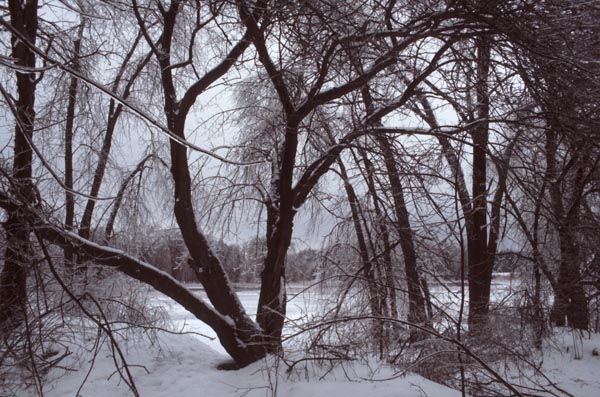Flashback – Photographs as Portals Back in Time – cb Blog #2
March 21st, 2012 by ChrisThe other day I was searching through photography files on my computer when I came upon an old friend – a scan of an image I had completely forgotten about. I had scanned the slide of “Icy Trees” in 2004, but hadn’t printed it in a darkroom since 1995, and I originally made the image in 1986. What struck me was that as I looked at this rediscovered image, I could hear the sounds of an icy forest after an ice storm that happened 25 years ago.
I’ve lived on or near the coast of central California my whole life. We’re lightweights around here. It gets below 40 degrees F, or above 80 and you’d swear the sky is falling. OK slight exaggeration, maybe … but the point is we have to travel to get winter. We don’t have to go too far … the Sierra Nevada mountains are nearby, but I was 22 when I took this photo, and the majority of my winter experiences at that time came when I’d visit my family in Massachusetts . The beauty of being an occasional visitor to places is you don’t tend to get bogged down by events that can be a nuisance, or worse. The thought of shoveling snow makes me smile, so you know I haven’t had a snow shovel in my hands too many times. And the thought of freezing rain? I know – roads ice up, power poles and trees crash down. It can be deadly. But this was the only ice storm this coastal Californian has ever seen, and all I remember is … Diamonds Everywhere. Diamond-encrusted everything!

Icy Trees – Taken along the Sudbury River in Wayland, Massachusetts – 1986
When we hang a photo on a wall we’re hanging a window, a portal. As you take a moment to look at/out that portal … you get to go somewhere. And unless you have any of those hard to come by photographs of the future … you are looking back in time. That is what art, photographs, stories can do for us. And then the memories come.
I must have taken “Icy Trees” with my first camera – a 35mm Nikon FM (simple and awesome) and an off-brand Tokina 28-85mm zoom lens. The film was probably Kodak Ektachrome 200 ASA slide film. Guessing by looking at the photo I must have shot it on a tripod, because it actually has decent foreground to infinity depth of field, so the lens was probably stopped down, and the exposure was slow. What that dry technical info means is the photo is not tack sharp. But I tend to be drawn to a more expressive rather than crystal clear aesthetic, and I like the image. Again. I must have gotten lucky with this one, because while I had already been collecting photography books by that time (I worked at a great used bookstore in Berkeley on Telegraph Avenue from age 16 – 19 – Moe’s Books is still going strong, and still has a great fine art book department), I’m not sure how much I knew about including foreground elements in landscape composition at that point. But the icy branch that extends down from the upper left corner of the image leads me into the picture and reminds me that everything is transformed with an icy coating after such a storm. It’s a dark moody image, and I like that it makes me feel that.
But what’s unique for me about this image is how it stirs my sense memory. It’s common to talk about how a photograph looks, but in my mind’s ear while I look at this photograph I can hear the surrounding forest snapping, popping and echoing off of everything that’s coated in hard reflective ice. The heavy, brittle tree branches start cracking with their own weight or the slightest breeze . A good blow and stuff starts really breaking – exploding. I can also hear the frozen river beyond – cracking out loud as the ice shifts. And there’s also that winter smell … cool, clean, sharp – just about the cleanest smell you can imagine. How accurate these memories are is beside the point for me. Photographs are inherently abstractions. They are two-dimensional freeze-frames taken by a subjective photographer intentionally including and excluding the visual elements in a camera’s field of view. They are shallow glimpses of vast reality, but … they can serve as portals. Whereas abstract imagery may take us somewhere mysterious or even unknown, more narrative images tend to take us to specific places guided by our past sensations – journeys back in time. This kind of experience is particularly human. Certainly a dog remembers where she hid her bone, and a crow remembers how to crack a walnut, but we can use an image on paper, or on a screen to seemingly meet again with a family member who’s passed on, or walk again in a forest we may have visited only once. For better, and worse … we can relive a moment of our past with all our senses. And that is (pardon the winter reference) … pretty cool.
Thank you for stopping by,
cb